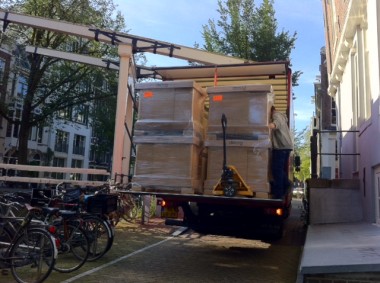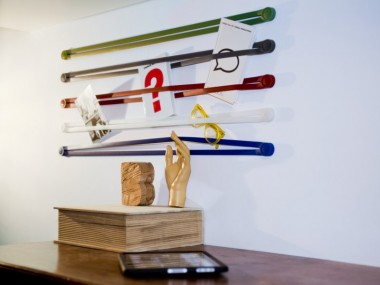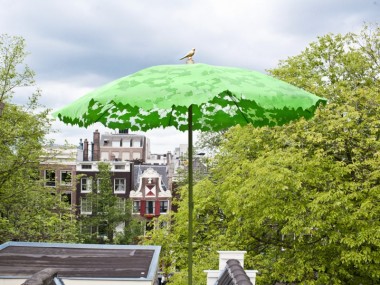Fantastical Investments: Excess is Essence
A surplus of ephemerals like earth and pigments stashed for years of intensive use.
A surplus of ephemerals like earth and pigments stashed for years of intensive use.
The exhibition installation for Fantastical Investments by Droog with Metahaven is starting today. Here are a couple photos from this morning.

Fi opens Thurs., Sept. 22nd with a panel discussion at 4:00 pm followed by the exhibition opening at 6:00 pm at Droog Amsterdam. RSVP for the panel to [email protected]
Thursday, September 22nd, 2011
Droog Amsterdam
We invite you to the opening of the exhibition Fantastical Investments by Droog with Metahaven. The imaginary brand, Fi, is the outcome of Droog Lab’s study of consumption habits in Russia in partnership with Strelka Institute for Media, Architecture and Design.
exhibition opening: 6:00 – 8:00 pm
We also invite you to the panel discussion moderated by Farid Tabarki, with Renny Ramakers (Droog), Daniel van der Velden (Metahaven), Olga Kuzina (economist and sociologist, Russia), Sjeng Scheijen (specialist in Russian culture, Leiden University) and Agata Jaworska (Droog).
panel: 4:00 – 6:00 pm
RSVP by Sept 20 [email protected]
(required only for panel)
exhibition on view until October 2nd
Tues – Sat 11:00 am – 6:00 pm
Sun 12:00 – 5:00 pm
twitter hashtag #Fi
Partner: Strelka Institute for Media, Architecture and Design
Supported by: Dutch Ministry of Education, Culture and Science and City of Amsterdam
Fantastical Investments by Droog Metahaven, in partnership with Strelka Institute for Media, Architecture and Design.
Thursday, September 22nd
4:00 – 6:00 pm panel discussion
6:00 – 8:00 exhibition opening
RSVP [email protected] (for panel only)
Fantastical Investments by Droog Metahaven, in partnership with Strelka Institute for Media, Architecture and Design.
Thursday, September 22nd
4:00 – 6:00 pm panel discussion
6:00 – 8:00 exhibition opening
RSVP [email protected] (for panel only)
A preview for our upcoming presentation of Fantastical Investments by Droog in collaboration with Daniel van der Velden (Metahaven) and in partnership with Strelka Institute for Media, Architecture and Design.
Save Thursday, September 22nd 4:00 – 6:00pm to join us for the panel discussion followed by exhibition opening at Droog Amsterdam until 8:00pm. RSVP [email protected] (limited spots!).
Australia’s Vogue Living featured an interview with Droog’s Agata Jaworska about Design for download.
“Droog is interested in developing new models for the design, distribution and production of design. Downloadable design is a whole chain redesigned and we are interested in innovating on both levels – on a system level and a product level. We’re always looking at structural innovation of supply chains for design – innovation on the level of the system behind design, not just innovative product design. We are interested in what the interaction will be with the user. How is a product distributed? What parts are transported? What parts are digital?”
– Agata Jaworska, Droog
Read the rest here.
Vogue Living also interviewed designer Herman Verkerk of Eventarchitectuur. Read the article here.
We have new photographs for Strap, Hang on easy, Shadylace parasol and Birdhouse by CMK1. Have a look.

Strap | Droog Accessories | by NL Architects

Shadylace parasol | Droog Accessories | by Chris kabel
Renny Ramakers is this week’s guest editor of Jotta.com. Here is an interview with Renny by Millie Ross and Chloe Spiby-Loh.
Renny Ramakers is the co-founder and director of Droog, a conceptual design company based in Amsterdam. Trained as an Art historian, in 1993 Ramakers decided to initiate projects which have since stretched the borders of design thinking. In celebration of Droog’s design for German disco DJ, Tensnake’s new album, Ramakers talks to jotta about the progressive ideas that define a design company as renowned as Droog. In keeping with Droog’s democratic ethos we asked 4 designers of different mediums, illustration, product, architecture and graphics, to ask the questions.
jotta: How would you describe the Droog aesthetic?
RR: The Droog aesthetic comes from content. It is straightforward but not minimalistic. It is both less and more (less aesthetic extras and more content). The Droog aesthetic is always open to changing.
jotta: How does Tensnake’s music align with the Droog design philosophy, and how did you approach the design coneptually?
RR: It’s not a collaboration, it’s a client, so it is not necessary that the two philosophies align. It’s more important that we can add to each other’s body of work. Responding to Tensnake’s layered approach to producing music and his love of African pattern motifs, the design features a series of artworks of superimposed found African patterns. The outer cover has been cut and folded to into a geometric pattern based on the idea of reptile skin scales. Just as a reptile’s scaled skin allows bright skin to be concealed beneath the scales, the white cover offers only a glimpse of its blue underside and the artwork selected by the user beneath it.

Dave Cuvelot: In your opinion what makes design such a powerful tool?
RR: It can bring an unexpected angle to a problem area. Design always depends on other industries and expertise, which are just as important. Continue reading “Renny Ramakers is guest editor for Jotta”
Friends of Droog are products by leading brands from around the world selected by us to complement the Droog collection. A special welcome to these new friends:
During July 2011, get a free copy of the Droog book ‘A human touch’ when you order over € 100,-.
DETAILS featured design for download in its 10 DO-IT-YOURSELF DESIGN PROJECTS THAT ARE LESS CRAFTY, MORE COOL by Monica Khemsurov.
When Droog launches its game-changing Design for Download website in the coming months, it will do for design in the 21st century what Ikea did in the 20th—democratize it—in this case by bringing design directly to anyone with an Internet connection, with no international shipping or middlemen required. Just choose and configure your design, download the schematics, and either take them to a nearby fabricator or give it a try yourself. Among the first online offerings will be open-source decorative electrical sockets, tables and chairs made with wood and 3-D printable brackets, and shelves whose composition can be customized using Droog’s new software.
Domus featured design for download in its design report by Valentina Croci:
Droog continues to explore programmatic design issues. The group’s focus has always extended beyond the trends to concentrate on processes, production chains and user applications since it was founded in 1993 by Gijs Bakker and Renny Ramakers. Always conscious of social and market signs and changes, Droog has been analysing goods production methods.
An opportunity for us to reflect and for you to see an overview, here is Everything we’ve done in 2009-2010. ‘saved by droog.’, new products, a new store in Las Vegas, and a whole lot more.
Artist Franck Bragigand has launched The Living Museum, a selection of painted actions realised around the world by the artist. It is an on-going museum, new performances will be added in the future.
Amongst works realized in Japan, Canada, Russia, United States, Morocco and elsewhere in Europe, seven videos feature projects with Droog.
The conference (Open talks, Pioneers of Change)
Paintings to auction
Continue reading “The Living Museum”
View the Droog profile video by Dutch DFA here.
by Renny Ramakers
In Suburbia: What a Concept published by the Opinionator of New York Times, Allison Arieff is certainly right when she says: “Addressing suburban ills requires massive change to systems, to finance, to transportation and infrastructure, and perhaps most challenging, to a culture deeply wedded to suburbia as emblematic of the American Dream.”
Most ills in this world (and we know there isn’t a shortage of them) require massive change on systematic and ideological levels. Indeed, it is a capacity—and many say, a responsibility—of design to address the many pressing problems facing the world today.
But is this the only role for design? Is design solely a form of crisis management and problem solving? Or can design also offer a different perspective on a problem, without having the aim of solving the problem entirely?
Service exchange in the suburbs
Our inspiration came from New York City’s service economy. In collaboration with Diller Scofidio + Renfro, we realized this system does not only create jobs and encourage social encounters, but also plays a psychological role for the service providers, in stimulating them discover something they are good at. We saw that the habit of outsourcing all kinds of life tasks by people in New York encourages others to invent their own professions.
We also noticed that many service providers we met created their profession with little investment and new infrastructure. Dany the trainer visited the homes of his clients to do training on their floor, Joshua the psychic held his practice in his home and Brian the dog walker only needed leashes and trust. It turns out that starting your own profession is possible with little or no capital.
We thought these dynamics had broader potential. Entering the suburbs, we did not intend to resolve the issues it faces, but rather to explore what value personal service exchanges might offer to suburbia.
We see Open House as a movement in which homeowners consider home business as a viable way to create a new role for themselves, which also increases interaction with neighbors, and possibly supplements one’s primary income. The one day event offered ideas and illustrated potential outcomes—some more realistic and some more speculative (or even fictional) than others. As a tool to help people discover their inner service providers, the event served to provoke visitors and participants to think for themselves about what might be useful for them as a business. We didn’t expect that the homeowners participating in the event would open up a business overnight.
Many services we encountered during our research in Manhattan appeared to be absurd at first glance (think of hiring someone to follow your spouse because you are suspicious of misbehavior, hiring someone to cut up your sofa so you can get it up your stairs, or signing up for a service to do yoga with your dog). The service economy has shown that what might start off as a strange business proposition, often turns out to address people’s actual needs and transforms into a serious business.
That’s what seemed to have happened at Open House #6: Attention Clinic by Claudia Linders. Though its inspiration, the Monty Python Argument Clinic of 1978, is more comical in its intent, the one-day Attention Clinic at 39 Old Oak Lane turned out to be surprisingly real for homeowner Polly Dwyer: “When you are 82 years old, people often ignore you because they think you don’t know anything. I was thrilled to find out people wanted advice from me. It turned out I had a lot of life experience that I could call upon and it wasn’t so difficult for me to do so. I wasn’t expecting this at all.” Though Polly does not plan to pursue the Attention Clinic (she has her plate full curating Levittown Museum and taking care of her husband), her participation in the one day event revealed a hidden capacity she hadn’t considered before.
A less unusual but equally earnest proposal was Open House #5: PS72 Porch-Side Lessons by Austin + Mergold with Spencer Lapp. PS72 was a teaching facility hosted at 72 Knoll Lane by Phyllis Dalton, a teacher and school principal who has been out of a teaching position for a few years. Designer Jason Austin explains: “Phyllis asked us to give her back her classroom. It was obvious to us that she had a lot of talent, but she seemed not to be able to market herself and her talent. The architecture became a platform for her service. We wanted it to support and display her talents and presence within the neighborhood.” Adopting a suburban vernacular, the materials for PS72 came primarily from Home Depot, including off-the-shelf plywood and lumber, lawn-mower wheels, plastic tarps and the American flag—an off-the-shelf garden accessory. The designers also adopted an institutionalized aesthetic to make the experience reminiscent of elementary school. “All aspects of the project were about developing infrastructure that was familiar and accessible to the suburban community.”
We also spoke with Phyllis after the event: “Once a teacher always a teacher,” she said. “I enjoyed passing on something that was not academic to people. I was able to use the teaching skills I had from my career for something that I was more passionate about.” Teaching the visitors two personal hobbies (collecting Hummels and making photo books), the 15-minute school session offered visitors a classroom experience, complete with a miniaturized version of a gymnasium, a library, a graduation ceremony and class photos.
The bigger issues
A few keen early-adopting homeowners with new business concepts are not enough to start the Open House movement. There are bigger issues to tackle, like outdated suburban regulations, and other issues rightfully raised by Arieff, including finance, transportation and infrastructure. The ninth house on the Open House tour addressed some of the broader implications of the Open House proposition.
In what was deemed the neighborhood showroom, Future Open Houses by EFGH (Hayley Eber & Frank Gesualdi) with Irina Chernyakova challenged existing rules of the suburbs and visualized the potential outcome of a bottom-up service economy on six blocks of Levittown. Regulatory modifications were proposed, including the possibility to convert private property (for example driveways) into public right-of-way (in for example, an drive-through service for sales or rentals), joint-use easements for two or more property owners to share a common feature (such as a mini storage facility or performance space built between two homes) or the modification of a occupancy group classification for the setting up of a public amenity (like a public theater, for instance). This house also presented sample floor plans of houses modified to host public services such as an art gallery, a love hotel, or a dog-sitting business.
Art gallery
Love hotel
Next steps
We see the event as a model for a future suburbia, which is not the model to solve all possible problems facing the suburbs. It is just a model to revive—to get more life—into suburbia.
The one day event was the first phase of the project. We are currently working on a publication which will deepen our insights, including those raised from these discussions.
In our work, we approach many serious topics, such as the rise in single living, sustainability, the increasing pace of life and the economic crisis in a playful way. We want to continue to generate debate by presenting models and possible scenarios with a light-hearted spirit. We are glad the debate has started.
Homeowners could adapt their existing homes to incorporate a service that is open to the public. Here are some examples which were presented by Charles Renfro at the Open house symposium on Saturday, April 23rd.

Extended living and dining rooms.

An art gallery.

A public library.

An extension for bed time stories.

A love hotel.

Dog sitting and backyard walking.
For more information, visit www.openhouse2011.com